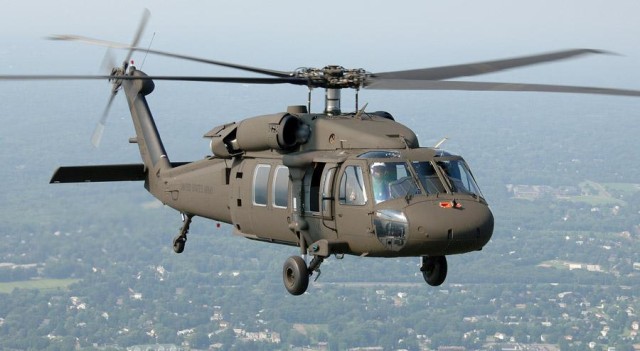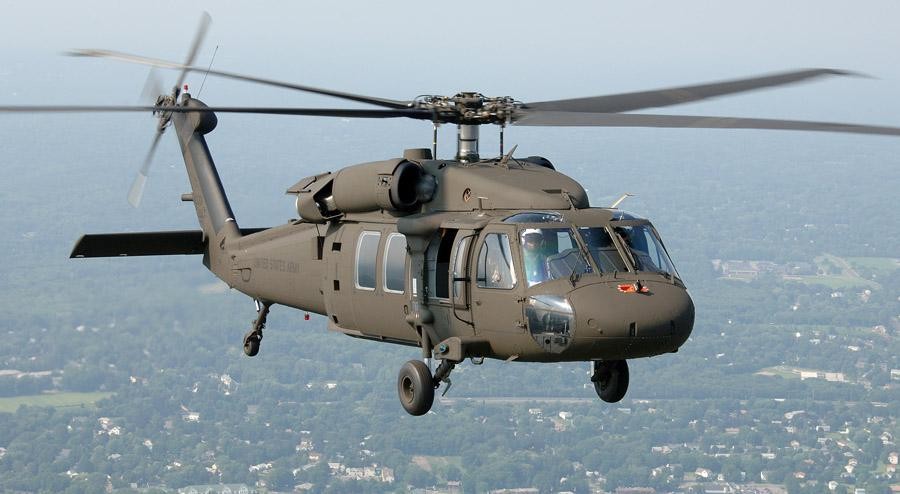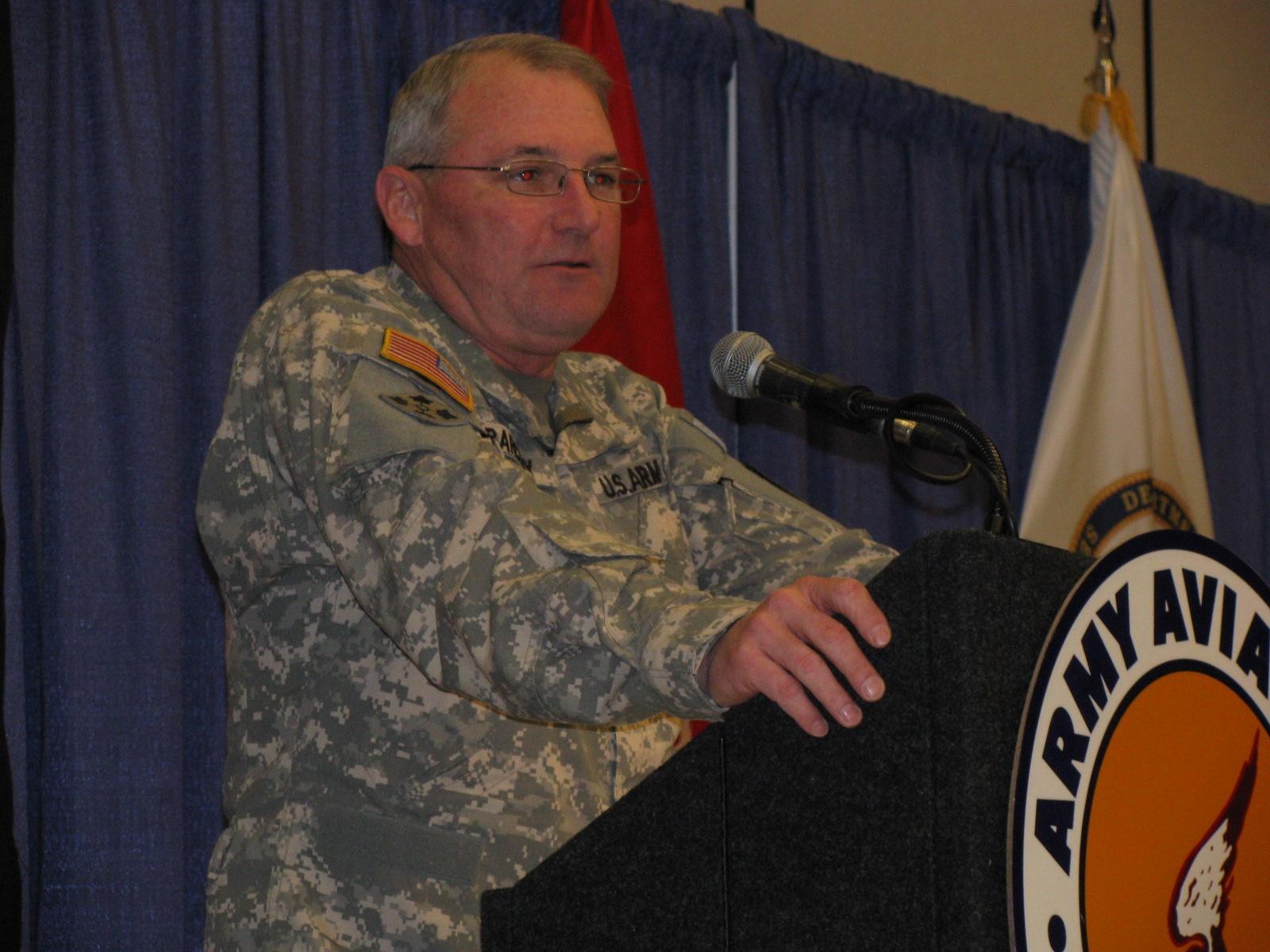The face of a young Soldier, a gun in his hands and the desert at his back, helped Maj. Gen. James Barclay III make his point at Thursday's luncheon meeting with about 500 aviation industry and military representatives during the 35th annual aviation symposium at the Von Braun Center.
Superimposed around the Soldier in the picture, which was projected on two large screens at the luncheon, were aviation systems that are symbolic of the work performed at the Army Aviation Center of Excellence at Fort Rucker, at the Aviation and Missile Command and Program Executive Office for Aviation at Redstone Arsenal, and throughout the Army's aviation industry.
"The most important part of what we do every day is that kid standing in the middle there," said Barclay, commander of USAACE and Fort Rucker, as he pointed to the Soldier.
"When you ask a Soldier what they think about Army aviation you will find out we have a great reputation. We bring a lot to the warfighter. But we have to continue to do that because this kid depends on us."
Barclay's comments were made during the Joseph P. Cribbins Aviation Product Symposium hosted by the Tennessee Valley Chapter of the Army Aviation Association of America. The theme for the two-day symposium was "Maintaining Aviation Excellence in a Wartime Environment."
Balancing the Army's two overreaching missions - one, to support the Army Force Generation (a movement to synchronize Soldiers, equipment, resources and training to ensure a global presence in the long-term combat of terrorism) and, two, to posture for the future - takes all elements of Army aviation working together.
"We are one team, one fight, one future. This is about Army aviation," Barclay said.
While the team of military aviation organizations and aviation industry businesses work for excellence on behalf of the Soldier, he said that same team must look toward preparing for future requirements.
"If we don't posture ourselves and take a hard look at where we need to be within just 10 years, 20 to 25 years, and beyond, then we are already behind the power ball," he said. "Our future is what kind of drives what we are doing today at not just Fort Rucker but throughout our team and with every aviation leader."
The Army's aviation community must work to support the Training and Doctrine Command as it recruits, trains and educates Soldiers, develops leaders, supports training in units, develops doctrine, establishes standards and builds the future Army. TRADOC is working to meet the demands of a nation at war while simultaneously anticipating future challenges and solutions.
As the Army's center of excellence for aviation, Fort Rucker has a key role in helping TRADOC shape and build the Army of the future, Barclay said.
"Our focus is on training and preparing the war fighter," he said of Fort Rucker and its mission to develop the Army's aviation capabilities through training, doctrine and testing. "We are looking forward to ensure that the units deployed can meet the mission task."
As the Army transforms itself into the Army Force Generation, it is focusing efforts with the enterprise approach.
"Three, four, five years ago, we were talking about an enterprise approach at Army aviation well before the Army came up with that idea," Barclay said. "The Army refers to Army aviation to guide them in an enterprise approach for the rest of the Army."
The enterprise approach involves sustaining the Army and its 600,000 Soldiers as military operations -- including counterinsurgency, humanitarian and large-scale reconstruction operations -- are conducted in nearly 80 countries. These missions are conducted with strategic partners during an era of persistent conflict, rapid change and protracted confrontation with terrorist groups and individuals who will use violence to achieve political, religious and other ideological ends.
In the enterprise approach, the Army is a $230 billion enterprise that is most effective when its efforts are synchronized Armywide. The enterprise approach recognizes that no organization or command, no matter how large, is capable of providing all the services needed to support military objectives. Processes to man, equip, train and sustain the Army enterprise must be done with fiscal responsibility through the efforts of organizations Armywide.
At USAACE, the enterprise approach is incorporated through the partnership it has with AMCOM, PEO-Aviation and the deputy chief of staff of the Army Forces Command, Barclay said.
"We are a leader in doing what's good for the war fighter," he said.
Barclay did say one challenge facing USAACE is the development of training platforms for future aviation systems.
"If we don't have training platforms we won't have anyone who can fly all these machines that are great and wonderful," he said, as he showed his audience a slide depicting the Army's future joint unmanned aerial systems, multi-role helicopters, theater lift helicopters, cargo aircraft, and intelligence, surveillance and recognizance systems. "We don't have anything on the books for a future training helicopter. We need to look at that."
Barclay's comments also included his appreciation to the entire aviation industry for its support of military aviators and aviation systems.
"I want to thank you for your team approach, and for having the perseverance to stick with it and not back away from requirements ... Thanks for what you do every day because without you we couldn't be as successful as we are," he said.
A West Point graduate and Scottsboro native, Barclay is the former director of the Joint Center for Operational Analysis-Lessons Learned, U.S. Joint Forces Command, Suffolk, Va. His past assignments include serving in Operation Provide Comfort in Iraq, an effort to protect Iraqi Kurds following their unsuccessful uprising against Saddam Hussein after a U.S.-led coalition ousted Iraqi forces from Kuwait in the 1991 Gulf War; being a part of a U.S.-led effort to restore democracy to Haiti in 1994; and serving in Operation Iraqi Freedom. His oldest son was injured while deployed with the Army in Afghanistan. His youngest son also serves in the Army.




Social Sharing